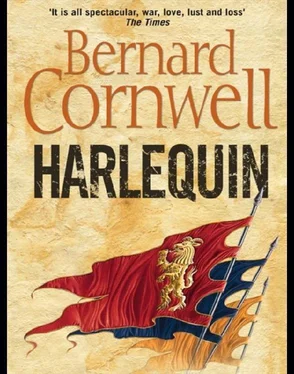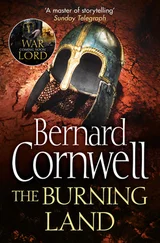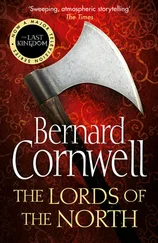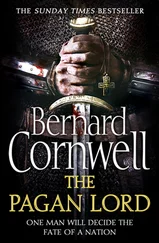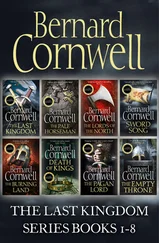And Sir Simon would let them. If these men hanged Thomas as a deserter then no one could accuse Sir Simon of executing the archer. He would have kept his word and the Earl of Northampton would still have to forfeit his share of the prize money. Thomas would be dead and Sir Simon would be both richer and happier. The men-at-arms were willing enough once they heard Thomas was a murderous thief They had orders to hang enough rioters, thieves and rapists to cool the army's ardour, but this quarter of the island, being furthest from the old city, had not seen the same atroci-ties as the northern half and so these men-at-arms had been denied the opportunity to use the ropes which the Earl had issued. Now they had a victim and so one man tossed the rope over an oak branch. Thomas was aware of little of it. He felt nothing as Sir Simon searched him and cut away the money pouch from under his tunic; he did not know a thing when the rope was knotted about his neck, but then he was dimly aware of the stench of horse urine and suddenly there was a tightening at his gullet and his slowly recovering sight was sheeted with red. He felt himself hauled into the air, then tried to gasp because of a dreadful gripping pain in his throat, but he could not gasp and he could scarcely breathe; he could only feel a burning and choking as the smoky air scraped in his windpipe. He wanted to scream in terror but his lungs could do nothing except give him agony. He had an instant's lucidity as he realized he was dangling and jerking and twitching, and though he scrabbled at his neck with his hooked fingers he could not loosen the rope's strangling grip Then, in terror, he pissed himself. Yellow bastard,“ Sir Simon sneered, and he struck at Thomas's body with his sword, though the blow did little more than slice the flesh at Thomas's waist and swing his body on the rope Leave him be,” one of the men-at-arms said. He's a dead Un," and they watched until Thomas's movements became spasmodic. Then they mounted and rode on. A group of archers also watched from one of the houses in the square, and their presence scared Sir Simon, who feared they might be friends of Thomas and so, when the Earl's men left the square, he rode with them His own followers were searching the nearby church of Saint Michael, and Sir Simon had only come to the square because he had seen the tall stone house and wondered if it contained plunder. Instead he had found Thomas and now Thomas was hanged. It was not the revenge Sir Simon had dreamed of but there had been pleasure in it and that was a compensation.
Thomas felt nothing now. It was all darkness and no pain. He was dancing the rope to hell, his head to one side, body still swinging slightly, legs twitching, hands curling and feet dripping. The army stayed five days in Caen. Some three hundred Frenchmen of rank, all of whom could yield ransoms, had been taken prisoner, and they were escorted north to where they could take ship for England. The injured English and Welsh soldiers were carried to the Abbaye aux Dames where they lay in the cloisters, their wounds stinking so high that the Prince and his entourage moved to the Abbaye aux Hommes where the King had his quarters The bodies of the massacred citizens were cleared from the streets. A priest of the King's household tried to bury the dead decently, as befitted Christians, but when a common grave was dug in the churchyard of Saint Jean it could hold only five hundred bodies, and no one had time or spades enough to bury the rest, so four and a half thousand corpses were tipped into the rivers. The city's survivors, creeping out of their hiding places when the madness of the sack was over, wandered along the riverbanks to search for their relatives among the corpses that were stranded by the falling tide. Their searches disturbed the wild dogs and the screeching flocks of ravens and gulls that squabbled as they feasted on the bloated dead. The castle was still in French hands. Its walls were high and thick, and no ladder could scale them The King sent a herald to demand the garrison's surrender, but the French lords in the great keep politely refused and then invited the English to do their worst, confident that no mangonel or catapult could hurl a stone high enough to breach their lofty walls. The King reckoned they were right, so instead ordered his gunners to break down the castle's stones, and the army's five largest cannon were trundled through the old city on their wagons. Three of the guns were long tubes made from wrought-iron strips bound by steel hoops, while two had been cast in brass by bell-founders and looked like bulbous jars with swollen oval bellies, narrow necks and flaring mouths. All were around five feet long and needed shear-legs to be swung from their wagons onto wooden cradles.
The cradles were set on planks of wood. The ground under the gun carriages had been graded so that the guns could point up towards the castle's gate. Bring down the gate, the King had ordered, and he could release his archers and men-at-arms in an assault. So the gunners, most of them men from Flanders or Italy who were skilled in this work, mixed their gunpowder. It was made from saltpetre, sulphur and charcoal, but the saltpetre was heavier than the other ingredients and always settled to the bottom of the barrels while the charcoal rose to the top so the gunners had to stir the mix thoroughly before they ladled the deadly powder into the bellies of the jars. They placed a shovelful of loam, made from water and clay soil, in the narrow part of each gun's neck before loading the crudely sculpted stone balls that were the missiles. The loam was to seal the firing chamber so that the power of the explosion did not leak away before all the powder had caught the fire. Still more loam was packed about the stone balls to fill the space between the missiles and the barrels, then the gunners had to wait while the loam hardened to make a firmer seal.
The other three guns were quicker to load. Each iron tube was lashed to a massive wooden cradle that ran the length of the gun, then turned in a right angle so that the gun's breech rested against a baulk of solid oak. That breech, a quarter of the gun's length, was separate from the barrel, and was lifted clean out of the cradle and set upright on the ground where it was filled with the precious black powder. Once the three breech chambers were filled they were sealed by willow plugs to contain the explosion, then slotted back into their cradles. The three tube barrels had already been loaded, two with stone balls and the third with a yard-long garro, a giant arrow made of iron.
The three breech chambers had to be worked firmly against the barrels so that the force of the explosion did not escape through the joint between the gun's two parts. The gunners used wooden wedges that they hammered between the breech and the oak at the back of the cradle, and every blow of the mauls sealed the joints imperceptibly tighter. Other gunners were ladling powder into the spare breech chambers that would fire the next shots. It all took time, well over an hour for the loam in the two bulbous guns to set firm enough, and the work attracted a huge crowd of curious onlookers who stood a judicious distance away to be safe from fragments should any of the strange machines explode. The French, just as curious, watched from the castle battlements. Once in a while a defender would shoot a crossbow quarrel, but the range was too long. One bolt came within a dozen yards of the guns, but the rest fell well short and each failure provoked a jeer from the watching archers. Finally the French abandoned the provocation and just watched.
The three tube guns could have been fired first, for they had no loam to set, but the King wanted the first volley to be simultaneous. He envisaged a mighty blow in which the five missiles would shatter the castle gate and, once the gate was down, he would have his gunners gnaw at the gate's arch. The master gunner, a tall and lugubrious Italian, finally declared the weapons ready and so the fuses were fetched. These were short lengths of hollow straw filled with gunpowder, their ends sealed with clay, and the fuses were pushed down through the narrow touchholes. The master gunner pinched the clay seal from each fuse's upper end, then made the sign of the cross. A priest had already blessed the guns, sprinkling them with holy water, and now the master gunner knelt and looked at the King, who was mounted on a tall grey stallion. The King, yellow-bearded and blue-eyed, looked up at the castle. A new banner had been hung from the ramparts, showing God holding a hand in blessing over a fleur-de-lis. It was time, he thought, to show the French whose side God was really on. You may fire," he said solemnly.
Читать дальше
Конец ознакомительного отрывка
Купить книгу
